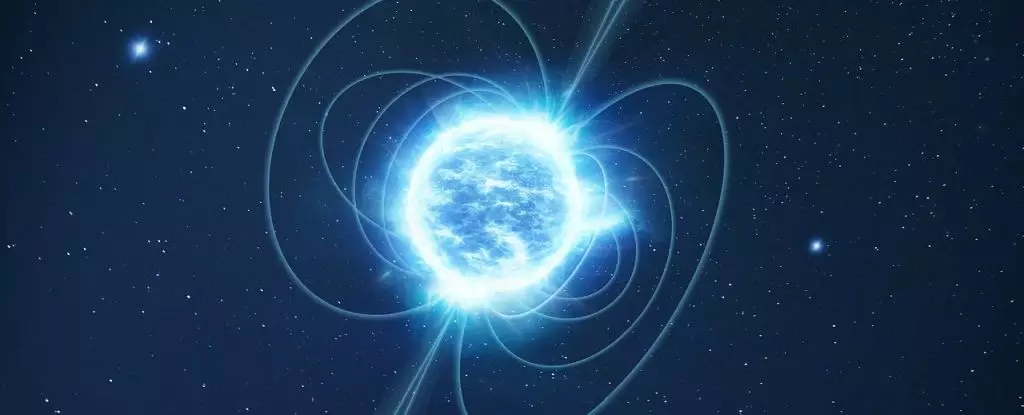In the celestial tapestry of the Milky Way, the magnetar known as SGR 0501+4516 emerges as an enigma, captivating astronomers and astrophysicists. These extraordinary neutron stars, characterized by their immense magnetic fields—some of the strongest known in the universe—pose intriguing questions regarding their formation and evolution. Recent observations utilizing advanced telescopes like Hubble and Gaia have revolutionized our understanding of magnetars, particularly SGR 0501+4516, challenging previously held assumptions about how such cosmic phenomena come into existence.
The Birth of a Magnetar: A Cosmic Mystery
Traditionally, magnetars were thought to originate from core-collapse supernovae—spectacular stellar explosions marking the end of a massive star’s life cycle. During this cataclysmic event, the star’s core crumbles under gravity, birthing a neutron star. However, the implications from the research on SGR 0501+4516 seem to undermine this theory, raising critical doubts about the underlying processes of magnetar formation.
The classification of SGR 0501+4516 as a magnetar—exhibiting a magnetic field a quadrillion times stronger than Earth’s—marks it as an outlier among neutron stars. While its existence suggested a straightforward lineage from supernova remnants—namely HB9, in close proximity—new observations complicate this narrative, challenging the established logic of cosmic birth.
Insights from Groundbreaking Observations
Recent data from Hubble and Gaia, ingeniously combined, have provided an unprecedented glimpse into the dynamics surrounding SGR 0501+4516. Astronomer Ashley Chrimes, leading a research team, meticulously charted the movement of the magnetar, discovering that its velocity and trajectory could not feasibly connect it to the remnants of HB9. This revelation casts doubt on the presumed lineage of the magnetar, pushing researchers to reconsider fundamental aspects of stellar evolution.
Moreover, the absence of nearby supernova remnants also presents a conundrum. If SGR 0501+4516 was born from a supernova, there should be vestiges of this explosive event. The current understanding indicates that if SGR 0501+4516 is indeed around 20,000 years old, it should have progenitor remnants, yet none exist. Such findings compel astronomers to explore alternative pathways for the birth of this extraordinary magnetar.
The Age-Old Question: What If Magnetars Aren’t Born from Supernovae?
As researchers delve deeper, the implications of these discoveries emerge: What if SGR 0501+4516 formed through a different process entirely? Two prominent hypotheses arise. The first suggests that the magnetar is older than previously thought, allowing any associated supernova remnants to have dissipated over time. However, this conjecture presents its own challenges, given that magnetars are typically viewed as transient phases—existing for only a few tens of thousands of years before transitioning into stable neutron stars.
The second alternative proposes a more radical paradigm—merger scenarios involving neutron stars or white dwarfs. Could SGR 0501+4516 be the product of two low-mass neutron stars colliding, or might it originate from a white dwarf consuming enough mass from its binary companion to trigger its collapse into a neutron star? This latter scenario, intriguingly posited by astronomer Andrew Levan, illustrates a different narrative for magnetar formation, inexplicably linking SGR 0501 to a more complex astrophysical ballet.
Implications for Astrophysics: A Potential Paradigm Shift
The implications of discovering that SGR 0501+4516 may not align with traditional supernova origins extend far beyond this singular magnetar. If astronomical observations continue to demonstrate that magnetars like SGR 0501 regularly differ from expected outcomes, an upheaval in our understanding of stellar evolution may ensue. This inquiry could lead to breathtaking revelations not just about magnetars, but about neutron stars as a whole.
The reconsideration of stellar life cycles may prompt astrophysicists to explore new cosmic narratives. Our knowledge of neutron star formation, magnetic field generation, and supernova mechanics could fundamentally shift, leading to innovative theories that embrace the complexities of the universe’s structure.
The Excitement Ahead: The Journey of Discovery
The journey into the mysteries of SGR 0501+4516 invigorates our quest for knowledge and challenges our cosmic perceptions. While the inherent uncertainties may tempt us to retreat into familiar narratives, the scientific adventure lies in embracing the unknown. Each new discovery etches its own piece of the grand astronomical puzzle, propelling humanity toward a deeper understanding of the universe’s most enigmatic objects.
As we venture further into this exploration, the narrative of SGR 0501+4516 may prove to be just the beginning. The magnetar not only represents a compelling case study but also serves as a rallying point for astronomers to probe the unknown, encouraging ongoing inquiries into the birth of stellar phenomena and the magnificent complexities of our cosmos. It is within these celestial mysteries that humanity’s thirst for understanding will continue to thrive, charting a enlightening course throughout the vast realms of space.

